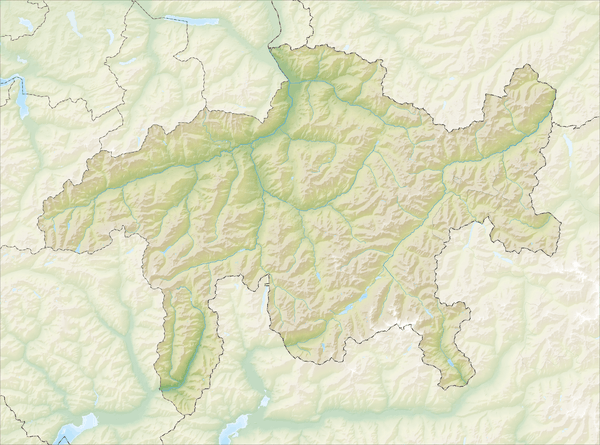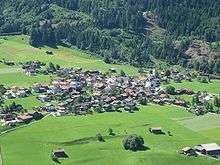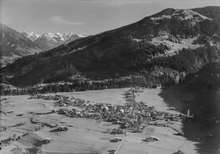Fideris
Fideris (Romansh: Fadrein) is a Swiss village in the Prättigau and a municipality in the political district Prättigau/Davos Region in the canton of Graubünden.
Fideris | |
|---|---|
 Fideris village church | |
 Coat of arms | |
Location of Fideris 
| |
 Fideris  Fideris | |
| Coordinates: 46°54′N 9°44′E | |
| Country | Switzerland |
| Canton | Graubünden |
| District | Prättigau/Davos |
| Government | |
| • Mayor | Reto Lippuner |
| Area | |
| • Total | 25.36 km2 (9.79 sq mi) |
| Elevation | 897 m (2,943 ft) |
| Population (2018-12-31)[2] | |
| • Total | 606 |
| • Density | 24/km2 (62/sq mi) |
| Postal code | 7235 |
| SFOS number | 3861 |
| Surrounded by | Conters im Prättigau, Jenaz, Küblis, Langwies, Luzein, Peist |
| Website | www SFSO statistics |
History
Fideris is first mentioned in 1370 as Fidris.[3]
Geography


Fideris has an area, (as of the 2004/09 survey) of 25.36 km2 (9.79 sq mi).[4] Of this area, about 58.7% is used for agricultural purposes, while 28.8% is forested. Of the rest of the land, 3.1% is settled (buildings or roads) and 9.4% is unproductive land. In the 2004/09 survey a total of 33 hectares (82 acres) or about 1.3% of the total area was covered with buildings. Of the agricultural land, 138 ha (340 acres) is fields and grasslands and 1,435 ha (3,550 acres) consists of alpine grazing areas. Since 1985 the amount of agricultural land has decreased by 65 ha (160 acres). Over the same time period the amount of forested land has increased by 65 ha (160 acres). Rivers and lakes cover 39 ha (96 acres) in the municipality.[5][6]
Before 2017, the municipality was located in the Jenaz sub-district of the Prättigau/Davos district, after 2017 it was part of the Prättigau/Davos Region.[7] It is a cross shaped linear village which lies on the Prättigau-Schanfigg route. It consists of the village of Fideris which is made up of the sections of Strahlegg and Fideris-Au.
In 1994, devotees of the Skanda Vale spiritual community in Wales bought a chalet near Fideris, and in 2016 this was inaugurated as a temple in its own right, now called Somaskanda Ashram. This temple draws pilgrims and devotees from across Europe.[8]
Demographics
Fideris has a population (as of December 2018) of 608.[9] As of 2014, 7.2% of the population are resident foreign nationals. Over the last 4 years (2010-2014) the population has changed at a rate of -4.24%. The birth rate in the municipality, in 2014, was 8.5, while the death rate was 5.1 per thousand residents.[6]
As of 2014, children and teenagers (0–19 years old) make up 19.4% of the population, while adults (20–64 years old) are 60.3% of the population and seniors (over 64 years old) make up 20.3%.[6] In 2015 there were 259 single residents, 270 people who were married or in a civil partnership, 42 widows or widowers and 29 divorced residents.[10]
In 2014 there were 243 private households in Fideris with an average household size of 2.36 persons. Of the 210 inhabited buildings in the municipality, in 2000, about 62.9% were single family homes and 15.2% were multiple family buildings. Additionally, about 42.9% of the buildings were built before 1919, while 11.4% were built between 1991 and 2000.[11] In 2013 the rate of construction of new housing units per 1000 residents was 3.43. The vacancy rate for the municipality, in 2015, was 1.59%.[6]
The historical population is given in the following chart:[12]

Languages
Most of the population (as of 2000) speaks German (96.4%), with Portuguese being second most common ( 1.2%) and Romansh being third ( 0.7%).[13] In the early Middle Ages the entire population spoke Romansh. However, in the 14th Century the Walser migration brought Walser German speaking immigrants to the valley. By the time of the Protestant Reformation the majority of the inhabitants of the village spoke German.
| Languages in Fideris | ||||||
| Languages | Census 1980 | Census 1990 | Census 2000 | |||
| Number | Percent | Number | Percent | Number | Percent | |
| German | 485 | 98.58% | 557 | 95.05% | 565 | 96.42% |
| Romansh | 6 | 1.22% | 6 | 1.02% | 4 | 0.68% |
| Italian | 0 | 0.00% | 2 | 0.34% | 3 | 0.51% |
| Population | 492 | 100% | 586 | 100% | 586 | 100% |
Politics
In the 2015 federal election the most popular party was the SVP with 32.4% of the vote. The next three most popular parties were the FDP (18.1%), the BDP (16.8%) and the SP (15.5%). In the federal election, a total of 203 votes were cast, and the voter turnout was 42.6%. The 2015 election saw a large change in the voting when compared to 2011. The percentage of the vote received by the FDP increased sharply from 10.4% in 2011 to 18.1% in 2015, while the percentage that the BDP dropped from 26.5% to 16.8%.[14]
In the 2007 federal election the most popular party was the SVP which received 39.8% of the vote. The next three most popular parties were the FDP (38.7%), the SP (15%) and the CVP (3.3%).[13]
Education
In Fideris about 72.1% of the population (between age 25-64) have completed either non-mandatory upper secondary education or additional higher education (either university or a Fachhochschule).[13]
Economy
Fideris is a mixed agro-industrial community, a municipality where agriculture and manufacturing play a significant role in the economy.[15] As of 2014, there were a total of 232 people employed in the municipality. Of these, 56 people worked in 19 businesses in the primary economic sector. The secondary sector employed 68 workers in 18 separate businesses. Finally, the tertiary sector provided 108 jobs in 27 businesses. There was one small business with a total of 43 employees.[16]
In 2014 a total of 3.4% of the population received social assistance.[6] In 2011 the unemployment rate in the municipality was 0.5%.[17]
In 2015 the average cantonal, municipal and church tax rate in the municipality for a couple with two children making CHF 80,000 was 4% while the rate for a single person making CHF 150,000 was 17.2%. In 2013 the average income in the municipality per tax payer was CHF 63,542 and the per person average was CHF 25,286, which is less than the cantonal average of CHF 69,964 and CHF 33,075 respectively It is also less than the national per tax payer average of CHF 82,682 and the per person average of CHF 35,825.[18]
Transportation
The municipality has a railway station, Fideris, on the Landquart–Davos Platz line. It has limited service to Landquart and Davos Platz.
Heritage sites of national significance
The Türmlihaus and House Nr. 41 are listed as Swiss heritage sites of national significance.[19]
References
- "Arealstatistik Standard - Gemeinden nach 4 Hauptbereichen". Federal Statistical Office. Retrieved 13 January 2019.
- "Ständige Wohnbevölkerung nach Staatsangehörigkeitskategorie Geschlecht und Gemeinde; Provisorische Jahresergebnisse; 2018". Federal Statistical Office. 9 April 2019. Retrieved 11 April 2019.
- Fideris in German, French and Italian in the online Historical Dictionary of Switzerland.
- Arealstatistik Standard - Gemeindedaten nach 4 Hauptbereichen
- "Arealstatistik Land Use - Gemeinden nach 10 Klassen". www.landuse-stat.admin.ch. Swiss Federal Statistical Office. 24 November 2016. Retrieved 27 December 2016.
- Swiss Federal Statistical Office - Regional portraits accessed 27 October 2016
- Swiss Federal Statistical Office - Amtliches Gemeindeverzeichnis der Schweiz - Mutationsmeldungen 2016 accessed 16 February 2017
- "The temple". Somaskanda Ashram. Retrieved 5 July 2019.
- Swiss Federal Statistical Office - STAT-TAB, online database – Ständige und nichtständige Wohnbevölkerung nach institutionellen Gliederungen, Geburtsort und Staatsangehörigkeit (in German) accessed 23 September 2019
- Swiss Federal Statistical Office - Ständige und nichtständige Wohnbevölkerung nach institutionellen Gliederungen, Geschlecht, Zivilstand und Geburtsort (in German) accessed 8 September 2016
- Swiss Federal Statistical Office STAT-TAB - Thema 09 - Bau- und Wohnungswesen (in German) accessed 5 May 2016
- Swiss Federal Statistical Office STAT-TAB Bevölkerungsentwicklung nach institutionellen Gliederungen, 1850-2000 (in German) accessed 27 April 2016
- Swiss Federal Statistical Office Archived January 5, 2016, at the Wayback Machine accessed 28-Oct-2009
- "Nationalratswahlen 2015: Stärke der Parteien und Wahlbeteiligung nach Gemeinden" [National council elections 2015: strength of the parties and voter turnout by municipality] (in German). Swiss Federal Statistical Office. Archived from the original on 2 August 2016. Retrieved 18 July 2016.
- "Die Raumgliederungen der Schweiz 2016" (in German, French, Italian, and English). Neuchâtel, Switzerland: Swiss Federal Statistical Office. 17 February 2016. Retrieved 14 December 2016.
- Federal Statistical Office -Arbeitsstätten und Beschäftigte nach Gemeinde, Wirtschaftssektor und Grössenklasse accessed 31 October 2016
- "Arbeitslosenquote 2011". Statistical Atlas of Switzerland. Swiss Federal Statistical Office. Retrieved 4 May 2017.
- "18 - Öffentliche Finanzen > Steuern". Swiss Atlas. Swiss Federal Statistical Office. Retrieved 26 April 2017.
- Swiss inventory of cultural property of national and regional significance Archived May 1, 2009, at the Wayback Machine 21.11.2008 version, (in German) accessed 28-Oct-2009
| Wikimedia Commons has media related to Fideris. |